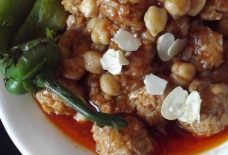Gooey Goodness: Ramallah's Stretchy Ice Cream Delights
What if a spoonful of ice cream could stretch out like melted mozzarella on a pizza?
“Mess!” you think. Or perhaps, “Fun!”
Ice cream with an elastic texture is a treat around the Levant. In Ramallah, two shops – with intertwined histories — cater to Palestinian cravings.
Rukab’s is the original. It opened in 1941 as a cafe in the same spot where it still stands. But 59-year-old Hassan Rukab, son of the founder, says his family’s ice cream business was operating much earlier.
“Before that, my grandmother used to prepare the ice cream at home. And they used to sell the ice cream after school,” he says.
Now, even at 10:00 a.m. on a weekday, people are already eating ice cream at Rukab’s.
They say they love the taste and the presentation. And oh yes, the stretchiness. Servers can pull the colorful ice cream into taffy-like strands over a foot long.
“I don’t know what is the secret behind the stretchy,” says Aida Samara, who has stopped by with work friends. “But anyone who eats it likes this stretchy thing.”
“It means good quality,” declares Fatma Shinee, a young woman who lives in Ramallah.
“I especially like it like this,” says Sami Tu’men, a businessman who lives an hour’s drive north but makes it a point to stop at Rukab’s whenever he is in Ramallah. Tu’meh says it reminds him of ice cream he had in Damascus, before the Syrian civil war.
It turns out he tried it at Bakdash, a landmark in Damascus that sources there say is still serving, and that has expanded to Jordan to cater to Syrian refugees there.
But the origins of this type of ice cream likely lie in Turkey.
There it’s called dondurma, and seems more sticky than stretchy in the many online videos of vendors teasing tourists. *
According to Mary Isin, author of Sherbet and Spice: The Complete Story of Turkish Sweets and Desserts, the Turkish variety is traditionally beaten with long wooden paddles while it is freezing to increase the stretchy texture.
Ingredients play a role, too, in both elasticity and slower melt times. Salep (from the root of a wild orchid) and mastic gum (the dried sap of the mastic tree) are traditional ingredients that add elasticity to ice cream, says Max Falkowitz, the resident ice cream expert at Serious Eats.
Both are “hydrocolloids,” he wrote in an email, “a class of chemical substances that form gels when immersed in water.” Gelatin and pectin are perhaps more familiar hydrocolloids in American kitchens.
“Different hydrocolloids make different kinds of gels,” he explained. “Mastic and salep, when mixed with fatty cream, milk, and sugar, happen to form chewy, gummy ones.”
Ramallah’s stretchy ice cream vendors both still use long paddles and some form of hydrocolloids to make their many flavors.
In the small factory of Baladna, workers use the paddles to push ice cream down as it whirls in modern Italian gelato machines.
Source: www.npr.org



